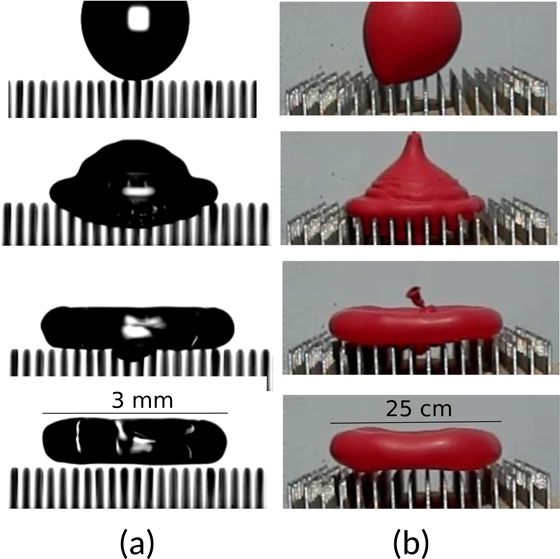Can you bounce water balloons off a bed of nails? Yes, says new study
14 Dec 2016 by Simon Davies A frame-by-frame comparison between the microscopic (left) and macroscopic versions of the experiment, showing the 'pancake bounce'.
A frame-by-frame comparison between the microscopic (left) and macroscopic versions of the experiment, showing the 'pancake bounce'.
A group of first year students at Roskilde University, supervised by Dr Tina Hecksher, have shown that water-filled balloons behave very similarly to tiny water droplets, by bouncing them on a bed of nails.
Their work, published today in the European Journal of Physics in collaboration with Professor Julia Yeomans at Oxford University, was inspired by one of Professor Yeomans’ previous papers studying water droplets bouncing on hydrophobic surfaces patterned with lattices of submillimetre-scale posts.
Dr Hecksher said: “We wanted to know if the so-called ‘pancake bounce’ effect – where the droplet lifts off the surface at its maximal extension – which was observed in the microscopic experiments could be replicated on a macroscopic scale.
“Scaling up the experiment allowed us to measure the impact forces in the pancake bounce, which gave a deeper insight into its dynamics. It also provides a really useful teaching tool to demonstrate to students in a very cost-effective, straightforward, and eye-catching way how these forces work.”
The study compared the impact of the balloons – taking the place of water droplets – landing on a flat surface and on a bed of nails – modelling the submillimetre posts. Using large store-bought party balloons, a digital reflex camera running at 300 frames per second to record the impact in slow motion, and a piezoelectric sensor under the board to log the impact force, the team measured impacts at different velocities and the balloons’ resulting behaviour.
They found the courses of the two impacts were initially similar. However, on the bed of nails, the balloon actually made a pancake bounce: it lifted off the bed of nails at its maximum deformation and began to retract in the air rather than on the surface. This is because some of the material penetrates into the nail pattern, recoils and – if the impact velocity is high enough – lifts the balloon off the bed of nails before it has time to retract.
Dr Hecksher said: “The behaviour of the balloons is surprisingly similar to that of millimetric bouncing drops. In particular, the pancake bouncing effect was reproduced showing the same reduction in contact time as in the microscopic experiment, but with absolute timescales longer by a factor more than 10. And the transition from normal bouncing to pancake bouncing happens at comparable impact parameters.
“In the future, it would be interesting to look at the similarity between water droplets and water filled balloons in more detail, by considering a greater range of balloon dimensions or higher Weber numbers, when drops break up upon bouncing but balloons cannot.”